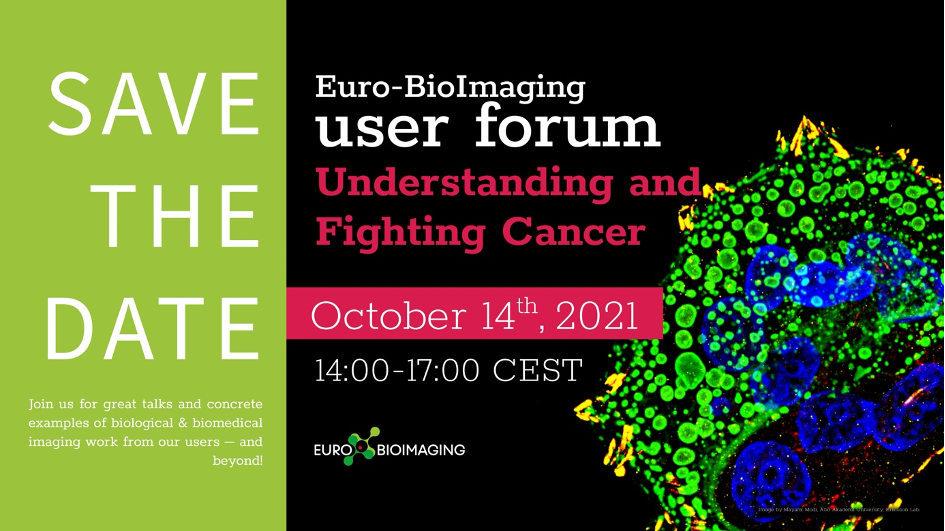
First Euro-BioImaging User Forum was a great success!
On Thursday, June 17 th, Euro-BioImaging hosted its first online User Forum: Fighting and Understanding Cancer. Over 220 people attended this event, including researchers, students, core facility staff, policy makers and industry representatives from 26 countries. Speakers hailed from 7 research institutes and 5 Nodes, imaging facilities that offer open access to imaging technologies and services through Euro-BioImaging. Euro-BioImaging thanks everyone who participated in this event - both speakers and audience – and hopes you will join us on October 14th for the second edition of the User Forum!
How do biological and biomedical imaging technologies contribute to understanding and fighting cancer? That was the overarching theme of the Euro-BioImaging User Forum, an online event that highlighted the importance of imaging to cancer research and showcased the specific expertise available at our Nodes for cancer research.

From diagnosis to treatment
Two outstanding lectures from our keynote speakers, Kevin Brindle, University of Cambridge, and Frank Winkler, DKFZ, highlighted the uniquely important role of imaging for cancer research. From using advanced light and electron microscopy tools in basic research to understand tumor biology and metastasis, to applying MRI and newly developed probes in early diagnosis and the development of better and personalized therapeutic treatments.
These talks were complemented by presentations from Euro-BioImaging Nodes, in tandem with the users of their facilities, demonstrating how researchers can advance their studies of cancer biology by making use of open access to imaging technologies and image analysis and the expertise of the Node staff through the Euro-BioImaging network.
From radiomics to tumor cell biology
Martijn Pieter Anton Starmans, of Erasmus University Medical Center, Rotterdam, explained how his research was supported by pipelines to test and evaluate different radiomics tools developed by the Population Imaging Node Rotterdam Flag of Netherlands, represented by Marcel Koek.
Dario Longo (CNR/University of Torino) explained how the Molecular Imaging Italian Node is developing GlucoCEST MRI, a new imaging-based approach for investigating tumor metabolism.
The role multimodal imaging plays in cancer research was highlighted by Andreas Walter’s (Austrian BioImaging/CMI) user story about investigating tumor vasculature with 8 different imaging technologies from in vivo imaging to high-resolution histopathology.
Jakub Sumbal, Masaryk University, showed us a new approach for detailed visualization of cancer organoids using droplet-stained co-cultures, developed with support from the Advanced Light Microscopy & Medical Imaging Node, Brno, represented by Milan Ešner.
Rossella Crescitelli, University of Gothenburg, gave us insight into how the Swedish NMI Node, represented by Julia Fernandez-Rodriguez, supported her research into methods to characterize extracellular vesicles from tumor cells, using Electron Microscopy.
Truly collaborative science
Recent big advances in preclinical and medical research have often relied on the development of cutting-edge imaging technologies. As these passionate presentations showed, Euro-BioImaging’s service offer goes beyond the acquisition of images on state-of-the-art instrumentation. Euro-BioImaging Nodes have their own unique specialization and expertise related to cancer research. The close collaboration between scientists and experts from open access imaging facilities such as Euro-BioImaging Nodes is leading to scientific outcomes that have a positive impact on human health.
Many thanks to all who participated in our first Euro-BioImaging User Forum and we look forward to seeing you again on October 14th for a new set of talks on Understanding and Fighting Cancer.
More news from Euro-BioImaging


